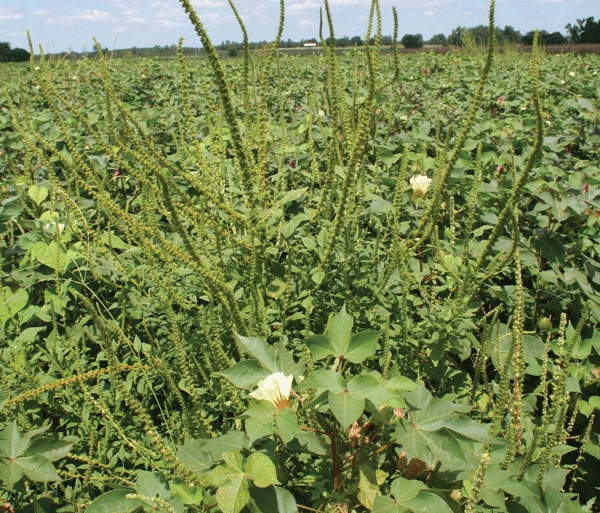
• Stanley Culpepper, Georgia Extension weed specialist, described the Georgia experience with amaranth species during the recent Texas Plant Protection Association annual meeting in College Station.• Growers created resistance with selection process by using only glyphosate herbicide, he said.• Deere has sold a lot of breaking plows.• Farmers are also hand weeding. They pull weeds and carry them out of the field.

Herbicide resistant weeds have changed the way Georgia cotton farmers manage their crop and the potential exists that similar situations may develop across the Cotton Belt if farmers fail to heed lessons Georgia growers have learned.
Stanley Culpepper, Georgia Extension weed specialist, described the Georgia experience with amaranth species during the recent Texas Plant Protection Association annual meeting in College Station.
“Amaranth species resistance is changing the way we grow cotton across the Belt,” Culpepper said. “We’ve seen significant changes the last five years because of this ‘super weed.’”
He said resistance came on rapidly in Georgia. “In 2004, we had resistance on one farm,” he said. “In 2005, we identified resistance in 2 counties. In 2009, we had 13 counties with resistant weeds.”
He said the problem occurs across the Southeast and Mid-south. “Growers created resistance with selection process by using only glyphosate herbicide,” he said.
Georgia may have been the first to have the problem and the effect on the way farmers manage their crops has been significant. “We lost about half our conservation-tillage acreage from 2004 through 2008,” Culpepper said. “We lost another 50 percent through 2010. John Deere has sold a lot of breaking plows. We’ve seen as much as a 20 percent increase in cultivation.”
He said cotton farmers also are turning back to incorporated herbicides. “We have to do it.”
Some are adding Liberty Link varieties to their operations and controlling weeds with Ignite herbicide.
Farmers are also hand weeding. “They pull weeds and carry them out of the field,” Culpepper said. A 2009 survey of 800,000 acres indicated 54 percent of the cotton was hand weeded. “Grower cost ranges from more than $3 an acre to $100 per acre. Average is $26 per acre. Total cost to hand weed the Georgia crop was $11.4 million.”
In 2010, Culpepper said, resistant weeds caused one farmer to lose a farm. He could no longer rent land.
It shouldn’t have gotten this bad, Culpepper said. “We tried in 2005 to get farmers to use a preventive program for about $35 an acre. No one would do it. Today, we’re spending $65 per acre on herbicides and hand weeding and cultivating. We’ve invested $130 million in Palmer amaranth control, and we’re not making much progress.”
He said resistance is real. In trials, they applied glyphosate at rates significantly higher than label rates and still did not get control. The weed out-competes cotton plants. “It does not shut down,” Culpepper said. “It will grow when cotton is wilting in the heat. They grow very fast and get extremely tall.”
Culpepper said just two plants per 20 foot of row can reduce yield by 23 percent. “It’s also a harvest efficiency disaster.”
Control seed production
He said cotton farmers have to learn how to control seed production from Palmer amaranth “or get out of cotton. A female plant produces a lot of seed, 300,000 to 500,000 per year. With that production, you only need one or two years before the weed becomes impossible to control economically. I prefer to get it in year one.”
He said plants also spread with pollen movement.
Culpepper said that even with excellent control as high as 99 percent, resistant Palmer amaranth seed production “will overwhelm us. We can’t do better than 99 percent.”
Ignite can be effective but has to be applied on a timely basis. If not, plants may be just stunted and will come back. “If you don’t get it the first time with Ignite, you probably will not,” he said.
So far, Texas has avoided the devastating resistance problems that have hammered Southeast and Mid-South cotton fields, but Culpepper recommends caution.
“Texas cotton farmers should accept the seriousness of the situation,” he said. “Georgia farmers took four years and now they are trying to catch up. Listen to your weed control specialists.”
He advises farmers to “pounce on small areas in a field” where suspected resistant weeds show up. “Pull them up. Don’t let them go to seed.
“Don’t expect new chemistry to save you. That’s not the answer. New ones will help, but it will still take an aggressive program with Palmer amaranth. Rotate chemistry and develop integrated programs.”
He said deep tillage may be a key. Palmer amaranth emerges from a shallow depth, he said, and seed life is not as long as once thought. “Seed require a lot of light to emerge so deep tillage, putting the weed seed 4 inches deep, will help.
“Make smart decisions over the next few years.”
Culpepper said “not one acre of Georgia cotton will be planted without an incorporated herbicide in 2010.
“We’re also using hooded sprayers. We can tank-mix Roundup and Diuron or Caparol. Every acre in the state will get a directed spray or hooded sprayer application,” he said.
Culpepper did a little math exercise to show how fast the problem can develop into a nightmare.
The first year, consider that five Palmer amaranth female plants escape and produce 2 million seed, of which 50 percent germinate. The following year an aggressive weed control program takes out 99 percent of the Palmer amaranth population, leaving 1,000 plants at harvest and 400 of them female. That means 160 million seed, which, at 50 percent germination, leaves 80 million.
Assuming another aggressive weed control program and another 99 percent success rate, 80,000 plants survive the next year, with 50 percent germination.
The next generation would be 1.28 multiplied by 10 to the tenth power, which equals — disaster.
About the Author(s)
You May Also Like





